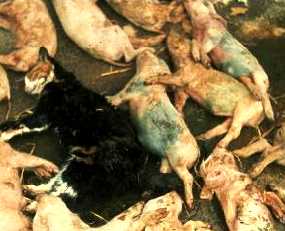



The Role of Biosecurity in Aujeszky's Disease/Pseudorabies Control
By Jake Waddilove MA, VetMB MRCVS - Aujeszky's Disease (AD), or Pseudorabies (PR) as it is also known, is an important worldwide disease. The economic impact of this disease is significant and it was estimated to cost the US pig industry $30 million per annum before eradication started. Some countries are free from the disease, while it is a major problem in others. Control and eradication remain the goal for this disease and biosecurity has a pivotal role in this.
 Jake Waddilove MA, VetMB MRCVS |
The pig is the natural host reservoir for AD/PR virus. It can infect other species including cattle, sheep, dogs, cats and rats but in all of these the infected animal dies, and these are known as end hosts. The virus can survive in the environment for up to 3 weeks.
Clinical Picture:
Clinical signs vary depending on the type of herd and its immune status. Acute outbreaks in naïve breeding herds are characterised by inappetence in a few sows, quickly followed by abortions. Next we see stillbirths and weak pigs born. Weak pigs and neonates become unthrifty, febrile, uncoordinated, convulse and die. Under 7 days mortality can reach 100%. Later on returns and mummified pigs are seen.
 Dead Pigs (and a cat), the result of Pseudorabies |
Herds with some immunity, or infected by less virulent strains of AD/PR, show much less obvious signs, and can be difficult to detect or differentiate from mild reproductive or respiratory disease of other causes. This is especially the case in finishing farms.
Importantly, following natural infection, a few animals develop a carrier state. These show no clinical signs and only shed virus when stressed or exposed to other disease (e.g. PRRS or PMWS).
How Is AD/PR Spread?
The main causes of spread are listed below:- Infected pigs - including carriers
- Airborne spread - at least up to 3 km
- Wild pigs
- Semen
- Vehicles
- Passive carriage on people or other animals
- End case hosts (cattle, dogs etc,)
- Slurry and slurry aerosols
- Birds (possibly)
Factors In Control:
|
Critical control points
in biosecurity to control Aujeszky's disease/Pseudorabies |
| Activity of Disinfectant Agents |
| Proven Activity Broad spectrum Properly cleaned surfaces Correct application |
| At the Farm |
| Location Perimeter fence Staff training Bird Proofing Wheeldips or sprays on approach Loading & unloading bays Feed deliveries Visitor control Downtime Showering or clothes change Preventing equipment entry |
| In Transport |
| All vehicles must be done Truck wash facilities Avoid cross-contamination Driver & farm staff training Loading & unloading Routeing |
| Incoming Pigs |
| Free source Safe transport Isolation position & duration Testing in Isolation |
| Incoming Semen |
| Free source Adequate source testing Good source biosecurity Safe transport |
One thing is certain about AD/PR in the long term - it is a disease that cannot be afforded in modern pig production.
As there are so many ways in which AD/PR can spread, biosecurity measures to control it have to be broad-based and thorough. Typically farmers need to use a comprehensive biosecurity programme such as the DAHS Swine Biosecurity Programme. A number of disinfectants are active against AD/PR virus, but if we consider the secondary role of other agents in the clinical syndrome, the triggering of shedding of AD/PR virus in the carrier stage by such as PRRS virus and PMWS, and the fact that we want to protect against other diseases, then it is best to use a proven broad spectrum disinfectant such as Virkon S (DAHS). As always prior to disinfecting, a heavy-duty detergent (Biosolve - DAHS) should be used to aid proper cleansing.
A very interesting way of reducing levels of AD/PR virus in the environment has been shown by the Prof. Sala's team in Milan & Bologna, Italy. They showed that in an AD/PR active unit, by using environmental air disinfection using Virkon S three times daily, the level of seropositive pigs at 60 & 90-100 days was significantly lower than in control pigs, and concluded this was due to reduced circulating virus in the environment.
An important aid to control has been the development of gene-deleted vaccines. These protect against the worst of the disease and reduce multiplication of the virus (and hence challenge to other pigs). However, since serological tests can differentiate between pigs vaccinated with these vaccines and those infected with wild virus, a cull of the latter will eliminate the virus in a herd provided that re-infection is prevented.
Control On An Infected Farm:
Antibiotics will not work against AD/PR virus but may help reduce secondary infections. Provided we can prevent re-infection on a farm, the aim should be to eliminate the virus. This can be done by depopulation - re-population followed by extensive cleaning and disinfection (Biosolve/Virkon S) and by re-stocking with known free stock. This technique is generally used where multiple diseases are present.
The other main approach is to remove weaners and growers to another site, weaning before 21 days. Then vaccinate the breeding herd with the gene-deleted vaccine. Clean and disinfect all accommodation. Then test a few weeks later with the differential test and cull any sows positive for wild virus. Repeat testing one or two times until all sows are negative. Ideally, maintain an aerial disinfection programme throughout this period using Virkon-S to reduce any viral circulation. Vaccination may be continued if there is a fear of reinfection from local farms. Weaners and growers can then be kept on the breeding farm, or remain in 2 or 3 site production. External biosecurity must be maximised to reduce the chances of reinfection (see below).
Control On A Free Farm:
Controls on a free farm are most important in a heavily infected area, but are vital in all free farms.
First buy stock only from known AD/PR-free farms with good biosecurity and a valid testing programme. Isolate at least 3 km away from the unit (and other pigs) for 6 weeks and test at least once for AD/PR before transferring to the main unit. Biosecurity of the isolation unit must be as good as the main farm and personnel and equipment should be separate. Semen should be purchased from AD/PR-free studs with a valid testing programme and good biosecurity. Vaccination of breeding stock may be done to reduce the chance of infection with AD/PR becoming established, and to reduce the effects if it does. Aerial disinfection can again reduce the chances of airborne infection.
Weaner, Grower and Finisher farms should buy from AD/PR-free breeding farms if they are free from the disease.
External biosecurity must be maximised on all types of farms. Perimeter fences are required to keep out wild boars, other animals and people. Biosecurity of transport is an important area. Vehicles used must be cleaned and disinfected prior to use (DAHS Vehicle Biosecurity Programme). One area of concern is truck washes. Never use the same site for both positive and negative hauling trucks due to the risk of cross-contamination. Disease breakdowns are more common in the winter and much of this is attributed to poorer vehicle biosecurity, as washes are not weatherproofed. All vehicles should pass through a disinfectant wheel dip or spray (Virkon S) prior to reaching the pig unit. They should deliver from outside the perimeter. Drivers should change overalls and boots on arrival.
Visitors to the unit should be kept to a minimum. Downtimes are enforced on units that have them. All personnel entering the unit should shower and change clothes if possible, but at least have clean overalls, hats and boots and use foot dips (Virkon S) and hand hygiene (DAHS Hand Hygiene System) prior to entry.
Control In A Given Area:
In AD/PR-free areas, control ingress of pigs and semen. Wild boars should be controlled. Biosecurity of transport is important, as is transit through the area. External biosecurity of farms should be maximised.
In infected areas vaccination will decrease challenge to uninfected farms. Often one of the difficult things is to get finishers, who experience fewer cost penalties from the disease, to vaccinate to keep the challenge in an area as low as possible. Once the financial resources for testing and control of movements are established, an individual farm-by-farm eradication plan using vaccination, cleaning and disinfection and culling should be undertaken. Vaccination is maintained until at least the main challenge in the area has passed. Provided that, movement controls and biosecurity of farms is good enough, AD/PR can progressively be eradicated from the area. Even then it is essential to maximise biosecurity of all farms to prevent re-infection of individual farms or the whole area.
|
The Activity of Virkon-S against the Pathogens Discussed in this Article
|
|||
| Agent |
Virkon-S Activity |
Test Country |
|
| Aujeszky's Disease/ Pseudorabies virus |
1:100 |
USA |
|
| PCV2 |
1:100 |
USA |
|
| Circovirus |
1:250 |
UK |
|
| PRRS |
1:700 |
UK |
|
| Mycoplasma hyopneumoniae |
1:800 |
UK |
|
| Actinobacillus pleuropneumonia |
1:200 |
UK |
|
| Pasteurella multocida |
1:150 |
UK |
|
Additional Information
For more information on Aujeszky's Disease/Pseudorabies - Click HereFor more information on Biosecurity - Click Here
For more information on DAHS and Virkon S - Click Here
References
- Ajariyakhajorn, C., Goyal, S. M., Robinson, R. A., Johnston, L. J., and Clanton, C. J. The survival of Salmonella anatum, pseudorabies virus and porcine reproductive and respiratory syndrome virus in swine slurry. Microbiologica 20, 365-369. 1997.
- Botner, A. Survival of Aujeszky's disease virus in slurry at various temperatures. Veterinary Microbiology 29, 225-235. 1991
- Brown, T. T. Laboratory evaluation of selected disinfectants as virucidal agents against porcine parvovirus, pseudorabies virus, and transmissible gastroenteritis virus. American Journal of Veterinary Research 42(6), 1033-1036. 1981.
- Christensen, L. S., Mousing, J., Mortensen, S., Soerensen, K. J., Strandbygaard, B. S., Henriksen, C. A., and Andersen, J. B. Evidence of long distance airborne transmission of Aujeszky's disease (pseudorabies) virus. The Veterinary Record 127, 471-474. 1990.
- Davies, E. B. and Beran, G. W. Influence of environmental factors upon the survival of Aujeszky's disease virus. Research in Veterinary Science 31, 32-36. 1981.
- Sala, V., Gusmara, C., Ostantello, F., Beghian, M., Effretti, F., and Rubello, U. The importance of a complete biosecurity programme for the control of viral respiratory infections in swine production. Anaporc conference, Spain, 2001
- Schoenbaum, M. A., Zimmerman, J. J., Beran, G. W., and Murphy, D. P. Survival of pseudorabies virus in aerosol. American Journal of Veterinary Research 51(3), 331-333. 1990.








